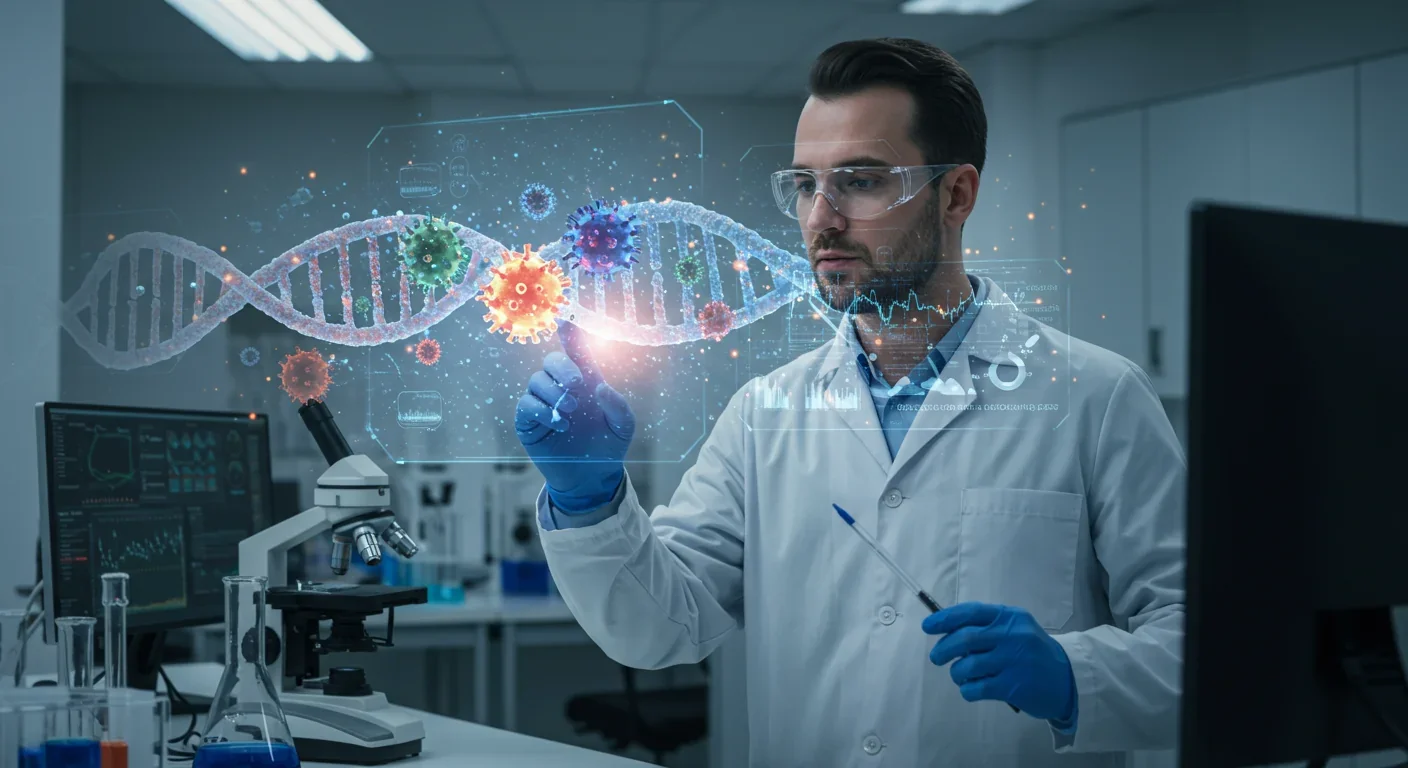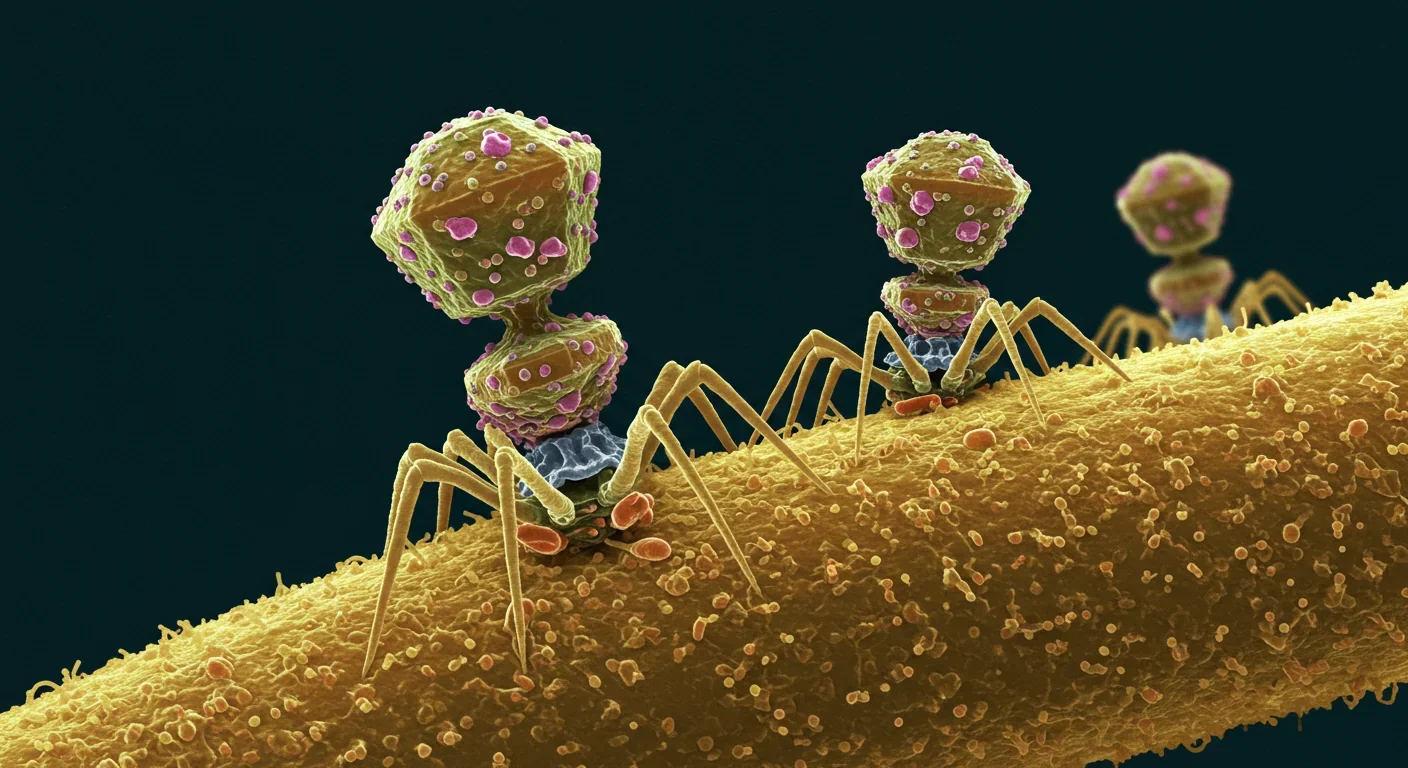Why Your Brain Sees Gods and Ghosts in Random Events

TL;DR: Viruses aren't just pathogens; they're evolutionary architects. Ancient viral DNA makes up 8-17% of human genomes, shaping everything from immunity to brain function, while bacteriophages drive microbial evolution and could become precision biocontrol tools.

Within your cells right now, ancient viral code is quietly doing its job. About 8% of your genome comes from retroviruses that infected your ancestors millions of years ago. These aren't dormant relics. Some help protect embryos from immune attack during pregnancy. Others might be linked to cancer. We've spent centuries seeing viruses as invaders to defeat, but scientists are discovering something far stranger: viruses are master architects of evolution, writing code into genomes and reshaping life on planetary scales.
Your genome tells a story of ancient infections. Human endogenous retroviruses, or HERVs, are fragments of viruses that inserted themselves into the DNA of egg or sperm cells long ago. Once integrated, they got passed down like any other gene. Today, they make up roughly 8% of human DNA, vastly more than the 2% that codes for proteins.
These aren't random scraps. Some HERVs actively shape how cells behave. Take ERVK3-1, a retroviral element recently studied in liver cancer patients. Researchers found that when ERVK3-1 is highly expressed, it correlates with poorer survival rates and influences how tumors interact with the immune system. High expression was linked to immune checkpoint proteins like PD-1, which cancer cells exploit to evade destruction. The virus-derived sequence wasn't just sitting there; it was helping orchestrate the tumor's metabolic reprogramming and immune evasion.
And ERVK3-1 is just one player. LINE-1 elements, another class of retrotransposons with viral ancestry, constitute about 17% of the human genome. In neurons, LINE-1 activity generates genomic diversity during development, creating a mosaic of slightly different cells that may enhance brain function. But when LINE-1 activates in aging neurons, the result can be DNA damage and neurodegenerative diseases like Alzheimer's and Parkinson's. It's a double-edged sword: vital for innovation during development, dangerous when deregulated later in life.
Viruses don't just edit individual genomes. They ferry genes between wildly different organisms, a process called horizontal gene transfer. Bacteriophages, viruses that infect bacteria, are virtuosos at this. When a phage infects a bacterial cell, it sometimes packages bits of the host's DNA along with its own. If that phage then infects a different bacterium, it can deliver those stolen genes, instantly gifting the recipient with new traits like antibiotic resistance or novel metabolic pathways.
A recent study tracked Escherichia coli exposed to T4 bacteriophage. Within 24 hours, the bacteria evolved complete resistance to the phage. Large deletions appeared in genes coding for phage receptors, locking the virus out. But here's the twist: when researchers then exposed these phage-resistant bacteria to iron stress, the prior viral pressure altered how they adapted. The bacteria retained phage resistance but showed different iron and antibiotic tolerance profiles compared to populations that had never seen a phage. The virus had shaped the bacteria's evolutionary trajectory, constraining and redirecting future adaptations.
This kind of viral influence scales up. In marine ecosystems, phages are the most abundant biological entities, outnumbering bacteria ten to one. They kill an estimated 20-40% of ocean bacteria every day, releasing massive amounts of organic matter that fuels microbial food webs. Giant viruses infecting protists carry genes for photosynthesis, nutrient transport, and stress response, suggesting they actively manipulate host metabolism to benefit viral replication. Some of these giant viruses have genomes larger than small bacteria, blurring the line between parasite and organism.

In agriculture, the story gets even more intricate. Insect-specific viruses don't infect plants, but they influence whether plant viruses spread. These ISVs alter insect physiology, reproduction, and immune responses. When an insect harbors an ISV, it may become a less competent vector for plant pathogens.
For example, the Nhumirim virus, a flavivirus, suppresses West Nile virus replication in mosquitoes in lab settings. Researchers are exploring whether engineered ISVs could be released to reduce transmission of devastating plant viruses like tomato spotted wilt virus. The idea is to weaponize one virus against another, creating a self-replicating biocontrol agent that spreads through insect populations and shields crops.
High-throughput sequencing has revealed that many insect species carry dozens of uncharacterized viruses. A survey of piercing-sucking insects found 441 distinct viruses across 74 species. Each one is a potential lever for manipulating ecosystems, for better or worse. This hidden viral diversity suggests we've barely scratched the surface of understanding how viruses govern ecological balance.
Beyond inserting genes, viruses have given rise to sophisticated regulatory networks. KRAB zinc finger proteins, a large family of transcription factors in mammals, evolved partly to silence endogenous retroviruses. Over time, these same proteins were co-opted to regulate non-viral genes, expanding the cell's toolkit for controlling which genes turn on and when.
One study mapped regulatory networks involving KRAB zinc finger genes and found extensive cross-talk with immune pathways, development, and stress responses. The viral sequences themselves, once silenced, sometimes became enhancers or promoters for nearby genes. In other words, the cell domesticated viral DNA, turning invaders into functional parts of the regulatory machinery.
This pattern repeats across the tree of life. In plants, viral-mediated gene transfer has introduced disease resistance genes and metabolic innovations. In bacteria, prophages integrated into chromosomes provide toxin genes that make pathogens more virulent, or anti-CRISPR proteins that help bacteria evade rival defense systems. Each integration event is a genetic experiment, and natural selection decides whether it stays or goes.
Not all viral contributions are benign. The same ERVK3-1 element that exists in every human can become a liability. When it's overexpressed in liver cells, it's associated with worse outcomes in hepatocellular carcinoma. Patients with high ERVK3-1 levels had significantly poorer overall survival. The viral sequence correlated with immunosuppressive signals, helping tumors evade T-cell killing.
Similarly, LINE-1 reactivation in neurons contributes to a range of neurodegenerative diseases. DNA damage from uncontrolled LINE-1 jumping disrupts chromatin structure and gene expression, accelerating cell death. Researchers have linked LINE-1 activity to schizophrenia, autism, ALS, and Huntington's disease. The very mechanism that generates neuronal diversity in a developing brain becomes a source of pathology when it escapes regulation.
These examples reveal a recurring theme: viral elements are powerful tools, but their activity must be tightly controlled. When regulation fails, innovation turns destructive.

Scientists are learning to exploit viral machinery. Viral vectors have become the workhorses of gene therapy, delivering corrected genes into patients with genetic disorders. Adeno-associated viruses, retroviruses, and lentiviruses are engineered to carry therapeutic cargo into target cells. These same vectors underpin many COVID-19 vaccines and cancer immunotherapies.
Red biotechnology, the branch focused on medical applications, leans heavily on viral systems. From producing recombinant proteins in mammalian cells to designing CRISPR delivery systems, viral biology provides the scaffolding. Even bacteriophages are being revived as treatments for antibiotic-resistant infections, a strategy called phage therapy.
In one recent innovation, researchers uncovered how bacteria "pirate" phage genes to fight off rival strains, a phenomenon dubbed microbial piracy. By understanding how bacteria weaponize stolen viral genes, scientists hope to design new antimicrobial strategies that turn bacteria's own tools against them.
Other teams are using machine learning to design synthetic bacteriophages from scratch. Generative models trained on phage genomes can propose novel sequences optimized for specific bacterial targets. If successful, this could create tailored phages for any pathogen, on demand.
Viruses have been shaping life for as long as life has existed. Evidence suggests viral genes appeared before the last universal common ancestor, making them integral to the earliest chapters of cellular evolution. Some scientists argue that viruses contributed to the origin of the cell nucleus, with large DNA viruses providing the blueprint for compartmentalization and gene regulation.
In the oceans, viruses drive nutrient cycling on scales that influence global climate. By lysing phytoplankton and bacteria, they release dissolved organic carbon that feeds microbial food webs. This viral shunt redirects carbon away from higher trophic levels and toward microbial respiration, affecting how much carbon dioxide the ocean can sequester.
Recent geomapping of pathogen-phage interactions reveals that phage diversity varies dramatically by geography, creating regional evolutionary pressures on bacterial communities. Pathogens in one location face a different suite of viral predators than those elsewhere, leading to divergent resistance strategies and genetic architectures. This spatial structure shapes microbial evolution across continents and ocean basins.
Understanding viruses as architects of evolution, not just agents of disease, changes how we approach health and technology. It means recognizing that some viral sequences in our genome serve essential functions. It means anticipating that new infectious diseases will emerge, not as accidents, but as products of ongoing viral innovation.
For pandemic preparedness, this perspective suggests monitoring viral diversity in wildlife reservoirs and tracking how viruses exchange genes. Virome analysis of wild mammals is uncovering thousands of unknown viruses, each a potential source of future outbreaks. By cataloging these viruses and understanding their evolutionary trajectories, we can predict which ones might jump to humans.
In agriculture, deploying viruses as biocontrol agents requires careful risk assessment. Releasing engineered ISVs to suppress plant pathogens could work brilliantly or trigger unintended ecological cascades. The key is understanding viral ecology deeply enough to predict consequences.
In medicine, the rise of personalized phage therapy hinges on mapping the interactions between individual patients' microbiomes and candidate phages. Resistance evolves quickly, as the E. coli experiment showed, so treatments may need to rotate phages or combine them with other antimicrobials.
Within the next decade, you'll likely encounter gene therapies derived from viral vectors, whether for cancer treatment, rare genetic disorders, or even aging-related conditions. The vaccines you receive may increasingly rely on viral delivery systems. If you develop a drug-resistant infection, your doctor might prescribe a cocktail of bacteriophages tailored to the specific bacteria causing your illness.
More subtly, the food you eat may be protected by viruses engineered to suppress crop diseases. The diagnostics you undergo could use viral markers as biomarkers for cancer or neurodegenerative disease. Understanding that viral elements within your genome influence your immune response, your cancer risk, and even your brain function might inform personalized medicine strategies.
This also raises ethical questions. If we can edit out ancient viral sequences linked to disease, should we? What happens when we remove elements that have unknown regulatory roles? And who decides which viral contributions are beneficial and which are harmful?
For most of history, viruses have been cast as villains. The germ theory of disease, antibiotics, and vaccines taught us to see microbes as enemies. But the deeper we look, the more we realize that viruses are woven into the fabric of life. They've shaped genomes, driven innovation, and sculpted ecosystems for billions of years.
This doesn't mean we should stop fighting viral diseases. COVID-19, HIV, and Ebola demonstrate the immense harm viruses can cause. But it does mean recognizing that some viruses, or the sequences they've left behind, are allies. They've given us genes for immune defense, regulatory networks, and even the placenta that makes mammalian reproduction possible.
The next frontier isn't just defeating viruses; it's learning to work with them. Whether that means harnessing phages to fight superbugs, using viral vectors for gene therapy, or simply appreciating the viral code humming away in our cells, the relationship between viruses and life is shifting from adversarial to collaborative.
We're beginning to see viruses not as mere pathogens, but as co-authors of the evolutionary story. Every genome is a palimpsest, overwritten again and again by viral invasions, each leaving a trace. Understanding those traces, and the forces that inscribed them, is key to navigating the biological future.
The viruses are already inside. They've always been. The question now is: what are we going to do with them?

Recent breakthroughs in fusion technology—including 351,000-gauss magnetic fields, AI-driven plasma diagnostics, and net energy gain at the National Ignition Facility—are transforming fusion propulsion from science fiction to engineering frontier. Scientists now have a realistic pathway to accelerate spacecraft to 10% of light speed, enabling a 43-year journey to Alpha Centauri. While challenges remain in miniaturization, neutron management, and sustained operation, the physics barriers have ...

Epigenetic clocks measure DNA methylation patterns to calculate biological age, which predicts disease risk up to 30 years before symptoms appear. Landmark studies show that accelerated epigenetic aging forecasts cardiovascular disease, diabetes, and neurodegeneration with remarkable accuracy. Lifestyle interventions—Mediterranean diet, structured exercise, quality sleep, stress management—can measurably reverse biological aging, reducing epigenetic age by 1-2 years within months. Commercial ...

Data centers consumed 415 terawatt-hours of electricity in 2024 and will nearly double that by 2030, driven by AI's insatiable energy appetite. Despite tech giants' renewable pledges, actual emissions are up to 662% higher than reported due to accounting loopholes. A digital pollution tax—similar to Europe's carbon border tariff—could finally force the industry to invest in efficiency technologies like liquid cooling, waste heat recovery, and time-matched renewable power, transforming volunta...

Humans are hardwired to see invisible agents—gods, ghosts, conspiracies—thanks to the Hyperactive Agency Detection Device (HADD), an evolutionary survival mechanism that favored false alarms over fatal misses. This cognitive bias, rooted in brain regions like the temporoparietal junction and medial prefrontal cortex, generates religious beliefs, animistic worldviews, and conspiracy theories across all cultures. Understanding HADD doesn't eliminate belief, but it helps us recognize when our pa...

The bombardier beetle has perfected a chemical defense system that human engineers are still trying to replicate: a two-chamber micro-combustion engine that mixes hydroquinone and hydrogen peroxide to create explosive 100°C sprays at up to 500 pulses per second, aimed with 270-degree precision. This tiny insect's biochemical marvel is inspiring revolutionary technologies in aerospace propulsion, pharmaceutical delivery, and fire suppression. By 2030, beetle-inspired systems could position sat...

The U.S. faces a catastrophic care worker shortage driven by poverty-level wages, overwhelming burnout, and systemic undervaluation. With 99% of nursing homes hiring and 9.7 million openings projected by 2034, the crisis threatens patient safety, family stability, and economic productivity. Evidence-based solutions—wage reforms, streamlined training, technology integration, and policy enforcement—exist and work, but require sustained political will and cultural recognition that caregiving is ...

Every major AI model was trained on copyrighted text scraped without permission, triggering billion-dollar lawsuits and forcing a reckoning between innovation and creator rights. The future depends on finding balance between transformative AI development and fair compensation for the people whose work fuels it.